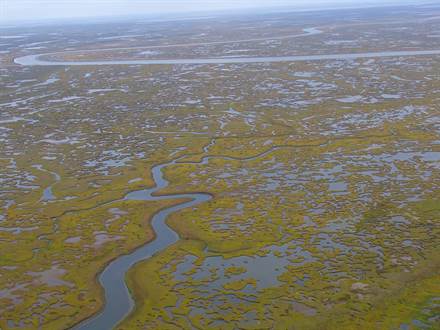
Birds and energy, why it matters on World Migratory Bird Day
-
Species
World Migratory Bird Day takes place 9-10 May. The theme of this year’s annual awareness-raising day is “Energy – make it bird-friendly!” Energy development is a critical issue for birds across their migratory routes. From the Arctic to Africa, there are increasing threats to migratory birds and their habitats from energy developments.
Many of the birds seen in Europe are long distance migrants, spending the European winter in Africa and breeding during the European summer in the Arctic. Millions of waterbirds migrate each year along the East Atlantic Flyway, spanning an area from the Russian Arctic to South Africa. As we prepare to celebrate World Migratory Bird Day ? and marvel at the long-distance journeys these birds make ? it’s important to highlight some of the places of critical importance to birds where we work that are at risk from energy development at both ends of the flyway.
According to Wetlands International CEO Jane Madgwick, “Plans for hydropower dams in West Africa and oil and gas drilling in the Arctic pose grave threats to migratory birds. The needs of birds and other species must be taken into consideration in order to sustain these outstanding wetland ecosystems. Actions to minimise the threats from energy production on migratory birds and the wetlands they depend upon are needed across the world’s flyways.”
Inner Niger Delta, Mali
The Inner Niger Delta, located in the West African country of Mali is hugely important to wetland-dependent birds. Fed by water from the Niger River, West Africa’s longest river, the Delta is one of the largest seasonal floodplain wetlands in the world, harbouring an estimated three to four million waterbirds.
These wetlands depend on annual wet season floods to inundate up to 30,000 km2 – an area the size of Belgium. Flooded forests provide habitat for some of the last large breeding colonies of cormorants, ibises, herons, and egrets in West Africa, and food from numerous species of fish.
It is vital to boost energy production in the underdeveloped countries along the Niger River. However, upstream hydropower, along with water diversions for irrigated agriculture and a drier climate are already threatening the Delta’s birds and other biodiversity. Reduced water flows are leading to the disappearance of flood forests and some fish species.
Now the World Bank has revived plans for a controversial upstream Dam, the Fomi. Our study on the impacts of the original Fomi proposal in 2006 showed that 60% of key waterbird habitats would be lost, pushing the breeding colonies to the edge of existence. Impacts on the people and wildlife of the Inner Niger Delta will be almost impossible to reverse should the dam prove detrimental. To ensure a living Inner Niger Delta for the future we are engaging closely in the current Fomi proposal.
The Arctic, Russia
At the other end of the flyway, interest in oil and gas production in the Arctic poses increasing risks for migratory birds. All of the world’s bird flyways converge in the Arctic, and waterbirds by the tens of millions fly north to the Arctic to breed in globally important areas.
The Arctic coastal tundra in the Nenets Autonomous Okrug in Northwest Russia borders the Barents and Kara Seas. It is among the most valuable areas for Arctic fauna including seabirds, waterfowl, waders and marine mammals.
Increasing oil and gas exploration and development in the Pechora Sea region is a growing threat to the Arctic ecosystems of the Pechora River Delta and the important waterbird breeding areas it contains. Offshore oil production will begin soon on the Prirazlomnoye oil field, located on the Pechora Sea Shelf, sixty kilometres offshore. A spill could have a devastating impact in this sensitive region.
The Ruff – from the Arctic to Africa
Ruffs (Philomachus pugnax) are an emblematic species for the challenges of energy development at both ends of the flyway for a wetland-dependent species. Ruffs spend their non-breeding season in sub-Saharan Africa, and hundreds of thousands have been counted in the Inner Niger Delta wetlands. These long-distance migrants depend on productive wetlands to ensure they have sufficient energy for their northward migration to their breeding grounds, where up to 95% of the population breeds in the Arctic. The wide-scale loss of wetlands at either end of the flyway could have dire consequences for Ruffs and many other species.
For more information
Statement of Wetlands International CEO Jane Madgwick on World Migratory Bird Day
Get involved in World Migratory Bird Day
Our work in the Inner Niger Delta
Our work on the Arctic to Africa flyway
Migratory Birds for People factsheet



